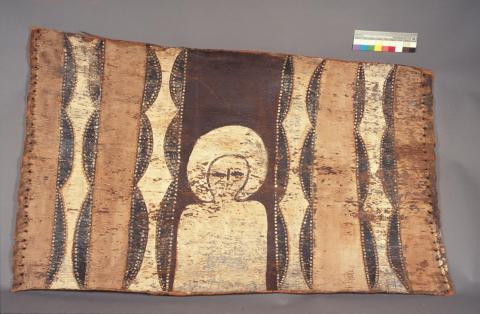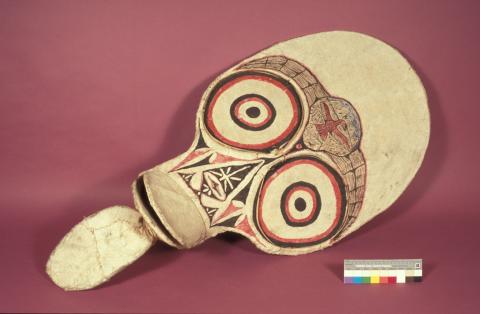Bark Paintings
Introduction
Bark paintings produced by Australian Aborigines are usually made from sections of the outer bark cut from eucalyptus trees. The bark is heated and weighted to produce a flat surface, scraped and then sometimes treated with natural resins before being painted.
Traditionally natural ochres, clays, minerals and charcoal were used for pigments. These were sometimes mixed with natural binders such as plant gums or blood. More recently PVA emulsion has been used to bind pigments. For the past 40 years, commercial acrylic paints have also been used.
Deterioration
Most conservation problems associated with bark paintings are associated with relative humidity. High relative humidity levels encourage mould and fungal attack on binders and can cause bark fibres to relax and return to their original curved form (Figure 2). Some of the traditional pigments, clays in particular, are able to absorb moisture from the air. This may eventually cause them to break up by flaking, blistering or cracking.
In addition, fluctuations in relative humidity cause bark to expand and contract, usually across the grain. Pigments, because of their different composition, generally react to fluctuations in relative humidity to a lesser degree than the bark. This causes tension at the pigment-bark interface which if left unchecked will cause the two to separate.
Initially, pigmented areas crack, then ‘tent’ and finally spall off. White pigment, perhaps due to its relatively coarser grain, appears to be more sensitive than other colours. Problems with changes in relative humidity are common due to the fact that many bark paintings may be produced in a humid area but end up in a drier region. Low humidity can cause shrinking in bark fibres and splitting and flaking of paint.
Physical damage may also be caused by insect attack of the bark itself.
Figure 2: Aboriginal bark painting. Ochre paint is flaking due to bark curling.
Preventive Conservation
Store and display bark paintings at relative humidity levels of 45 – 55 % with a maximum fluctuation of 5 % in any 24 hour period. A stable environment is most important as twisting and warping may occur otherwise. Maintain temperatures in the range 15 – 25 °C with a maximum variation of 4 °C in any 24 hour period.
To prevent dust accumulation, store bark paintings flat and covered with acid-free tissue or in archival quality cardboard boxes. Support any curved areas with dacron or polystyrene beads in washed cotton or linen (Figure 3). Keep the storage area clean.
Figure 3: Decorated bark from New Britain. A cloth mask needs support before going into storage.
To minimise fading of dyes and natural pigments, maintain light levels at a maximum illuminance of 50 lux with minimal UV radiation (less than 30 µwatts/lumen).
As bark paintings respond to changes in their environment they will be damaged if they are attached to rigid supports which restrict these responses. It is important to allow the painting some flexibility. Recently, fibreglass backings have been applied to some bark paintings with foam inserts which permit movement. Unfortunately, the fibreglass backing technique is time consuming, involves the use of toxic chemicals and is very expensive. More practical methods using aluminium strips and polyethylene foam have been developed (Coote 1995). As the backing procedure is highly specialised, consult a qualified conservator for advice.
Inspect paintings regularly to guard against insect attack.
Treatments
While some details are given below of ways in which bark paintings can be treated, this work should be left to conservation professionals. Seek advice from a conservator rather than attempt to carry out work yourself.
Cleaning
Cleaning bark paintings which contain traditional pigments may be difficult because these pigments often become powdery as they age.
If consolidation of the pigments is needed, and dust is found on the painting, remove the dust to prevent staining of the pigment during consolidation. Use a very soft brush, preferably sable, with a very light action. Due to the sensitivity required, ask a conservator to carry out this work.
Although it is possible to clean acrylic painted areas in good condition with cotton swabs that have been slightly moistened with water, avoid using water and organic solvents to clean bark paintings. If moistened cotton swabs are used, do not contact the bark and dry the cleaned areas immediately. Use dry cotton swabs or something similar for this latter task.
Consolidation
Traditional pigments used in bark paintings often require consolidation. The main risk associated with consolidation is staining or darkening of the pigments by the consolidant. As results vary from painting to painting, test a range of possible consolidants before commencing full-scale treatment. Consolidation is a specialist task, requiring the skills of a conservator.
Although cellulose-based consolidants have less cohesive and adhesive strength than their synthetic counterparts, their use is generally recommended. Synthetic resins are not in keeping with the natural materials used in bark paintings and may produce a surface which is both glossy and prone to yellowing.
Carboxymethyl cellulose (CMC, 5 g in 100 ml of water) is a widely used consolidant that rarely stains pigments. As CMC may affect any water-soluble pigments present in a painting, test it before application.
If flakes are lifting, introduce a consolidant beneath the flakes, with the flakes then gently laid down with the aid of silicon-release paper and weights.
Powdery areas may require application of the consolidant over the pigment surface. Do this by wetting out the pigment with ethanol (after testing for staining) and then manually applying the consolidant. The ethanol helps to draw the consolidant into the pigment and in some cases helps to reduce staining.
Occasionally, consolidants are sprayed over the bark surface. Although time-efficient, this procedure may not provide the thoroughness or penetration of consolidant that is achieved by working manually.
Other adhesives, which can be used include ethulose, potato starch, Klucel G and Klucel EF. Although the Klucel products (cellulose ethers) do not give a particularly strong bond, they have the advantage of being soluble in ethanol. Klucel EF is especially useful as it has a lower molecular weight than Klucel G and a more concentrated solution can be achieved without the viscosity which makes application difficult.
Note that cellulose-based consolidants are prone to mould attack. Display and store paintings treated with these materials in a stable environment with a relative humidity in the range of 45 – 55 %.
Insect Attack
Consult a conservation specialist if insect attack is a problem.
Oxygen deprivation is the most appropriate technique for insect control in bark paintings. Details of this technique are provided elsewhere (see the chapter Mould and Insect Attack in Collections). This approach is the least likely to damage the pigments.
Chemical fumigants and freezing techniques are not recommended as both will have deleterious effects on pigments in bark paintings.














